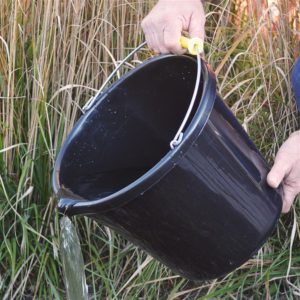It’s a process I’ve repeated hundreds of times in my 46 years. Rinse and pat dry a dozen or more small steaks one last time. Dip each piece in a wash of egg and milk, then roll in a dry mix of flour, cornmeal, mashed potato flakes and seasonings. Repeat the wash and dredge a second time. Then ease the pieces into a skillet of warm cooking oil. A couple minutes on each side and the venison tenderloin steaks come out irresistible mouth-watering wild game goodness.
Late fall and early winter means more than harvesting crops, readying equipment for winter and topping off the woodpile. It’s the most active time of the year for hunters. Hunting wild game using good sportsmanship and integrity takes a lot of effort and attention to detail. But getting an animal is only the start of the journey. Harvesting the meat and preparing it in a pleasing and tasty manner for your family or friends is a skill all its own. Fortunately the techniques used in butchering wild game are the same used in processing farm animals for meat. All it takes is a basic understanding of meat cuts and a few inexpensive tools.
I first learned to process larger animals during annual wintertime butchering days at my grandpa’s farm. The day would start by heating 55-gallon drums of water over a wood fire to help with the process. Grandpa and grandma had three children, all married, and a combined total of 15 grandchildren. In one long day every adult and child would pitch in help process three or four large hogs. The men would handle the initial butchering, then grandkids would carry the tubs of pork into the farmhouse where every available table and flat surface was covered with plastic tablecloths and butcher paper. The women and older grandkids would methodically cut and package the meat. Grandma would be starting the process of making head cheese on the wood-burning cook stove, and some hams and slabs of pork belly would be set aside to be hung in the smokehouse. Long after sunset, when the families packed up and headed back to their own homes, each would take coolers full of freshly packaged pork chops, steaks, roasts and sausage. On a visit a few weeks later we’d pick up hickory smoked hams and bacon.
 When I started hunting deer as a young man and chose to process my own game – to save costs and assure I was eating my own animal – I relied on those early butchering experiences. I also turned to a great little book titled “Basic Butchering of Livestock and Gameâ€. The book is a quick reference for double checking the details I might have forgotten. For the visual learner there are also video sets showing how to butcher. Keeping everything clean and sanitary and maintaining the meat in the right temperature range are the two most important things. Then it’s simply a matter of following the steps to reduce the large quarters of meat into freezer packaged food for my family for months to come.
When I started hunting deer as a young man and chose to process my own game – to save costs and assure I was eating my own animal – I relied on those early butchering experiences. I also turned to a great little book titled “Basic Butchering of Livestock and Gameâ€. The book is a quick reference for double checking the details I might have forgotten. For the visual learner there are also video sets showing how to butcher. Keeping everything clean and sanitary and maintaining the meat in the right temperature range are the two most important things. Then it’s simply a matter of following the steps to reduce the large quarters of meat into freezer packaged food for my family for months to come.
The first step in making any hands-on project enjoyable is having the correct tools. The number one thing for making home butchering comfortable is a gambrel to hold the carcass at a comfortable height for working up. I hang deer in my workshop with the gambrel suspended using a rope and pulley set and a rafter.
Before I get started I set up a few portable folding tables and cover them with food-grade plastic sheeting. I have several large cutting boards and a half-dozen butcher knives that are sharp. I keep a honing steel sitting on each table for easy access to bring the edges back in alignment for the best cutting.
As you process the quarters down into more usable sizes you will need a meat saw. If you already butcher your own farm animals you likely already have a good saw on hand. A cleaver has its place for chopping through smaller bones, but you’ll want to make some clean cuts. For occasional home butchering a hand-operated meat saw is sufficient. Butcher shops use powered bandsaws, but I’ve processed two to five deer per season for years and never felt the occasional task warranted the added expense.
Once we have the meat into manageable chunks we transfer it to the tables. There, on the large cutting boards, we separate out a few roasts and carve much of the remaining venison into steaks. Half of our immediate family are not big fans of roasts so we tend to lean toward pan-friend steaks. We package the steaks based on enough for a meal, and butterfly the smaller pieces to make larger steaks for frying. We’ve tried freezer bags in the past, but find that wrapping the meat in plastic wrap and then butcher paper fastened with either tape or string makes for a more freezer-hearty package.
Anything usable but not suitable for a roast or steak goes into freezer bags to be ground for venison burger or sausage. The first few years we’d stay with the butchering process start to finish … and usually had the job completed a couple days after first harvesting the animal. But for the past few years our son has been away at a university on the other side of the state. He comes home to deer hunt the opening weekend of season, but then has to return to school for a week or two until he can make the journey back home for Thanksgiving break. Since he was a young teenager, he’s always liked to take the lead on making the ground venison, sausage and jerky. We found that even when he was in high school and lived at home it made for a more enjoyable experience to do the initial butchering and then save the sausage and jerky making for a different time.
So come Thanksgiving break he gets out the hand-cranked meat grinders and sausage stuffer. The packages marked “grind meat†will come out of the freezer to be thawed and we’ll mix it in about a 60/40 ratio with pork fat and a little pork meat. We usually get the fat at no cost from a local meat market we frequent. For a couple days we’ll grind meat and package it again for use in chili and other recipes. About a third of the meat will be mixed with a few seasonings and even more ground pork to be made into breakfast sausage. We package some loose for patties, and stuff some in casings for links.
The remaining third of ground venison and pork gets run through the grinder a second time and made into jerky. Different spices are added and the finely-chopped meat is squeezed through a jerky gun onto plastic trays. Then the trays go in the dehydrator for several hours to make tasty dried treats.
From time to time we’ve packaged some of our jerky and given it as Christmas gifts to friends and relatives. We’ll put a handful of strips in a bag and wrap it with brown paper cut from grocery store bags. Then we’ll tie the wrapping in a bow made of baling twine. It makes a pleasing and tasty gift.
A couple times over the years, for a mixture of reasons, I’ve taken a deer or two to a commercial processor to be butchered and packaged. Not once have I came away feeling like I got my money’s worth. Maybe they did a good job, but the cost is often steep. And I have little connection to the assorted cuts as I take them out of the package and put them in the skillet. With meat I’ve processed myself I know what went into it, both work and ingredients, and I get an extra sense of enjoyment when I prepare and eat it.
Happy hunting!





























